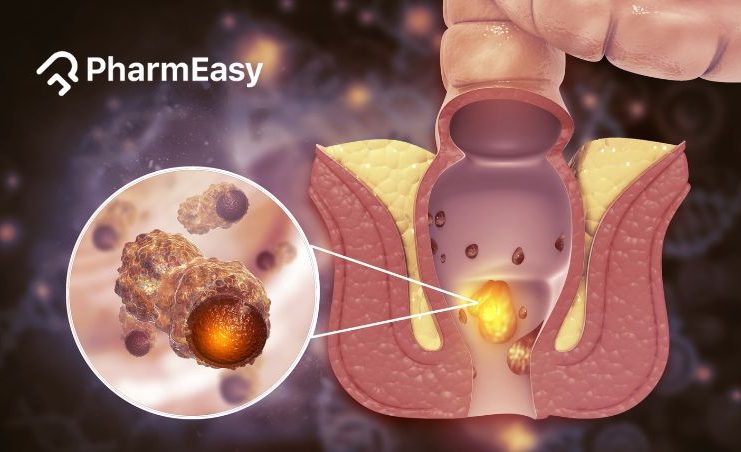Piles in Female (Women): Symptoms, Causes, and Treatment
By Dr. Mayuri Pandey +2 more

Get more insightful and
helpful tips to
treat Diabetes for FREE



Download PharmEasy App




Register to Avail the Offer
Send OTPBy continuing, you agree with our Privacy Policy and Terms and Conditions
By Dr. Mayuri Pandey +2 more
Table of Contents
Do you experience pain, itchiness, and swelling in the area of your anal opening? Do you notice blood after you poo and have difficulty sitting? These signs are indicative of piles or haemorrhoids.
The most commonly asked questions include: Why piles occur in females? Reasons of piles in females? Piles, also known as haemorrhoids, occur due to high pressure in the blood vessels.1 The blood vessels in the rectum are stretched as a result of increased pressure, which causes more swelling and the development of piles. Piles can occur at any age but are more common during pregnancy affecting approximately 25% to 35% of women, especially during the third trimester.2

If you are experiencing piles, book an appointment with a doctor near you and get prompt medical care for your condition.
Read more: Difference Between Piles and Fistula
Around 40% of haemorrhoids are painless and asymptomatic. However, in the remaining 60% of patients, the following early symptoms of piles in females are noticed:
The early symptoms of piles in females are much milder and can be treated easily by a medical professional. As it progresses, the symptoms of piles in females worsen, including:
Type 1: Haemorrhoids are located inside the anal opening and are usually small and painless inflammations. Small amounts of blood may be noticed after a bowel movement.
Type 2: The swelling is larger than that in Grade 1, and the anal opening is also affected. The swelling may protrude outside during bowel movements, but they usually returns to its place later.
Type 3: Swelling is noticed outside the anal opening, and a lump will be noticed by the individual. These have to be physically pushed back with the fingertips (Prolapsed Haemorrhoids)
Type 4: The swelling bulges outward and falls out even if forced back into the rectum. Bleeding may or may not be present. Pain may be present if a clot forms or if the haemorrhoids are strangled by the anal opening.
Even though piles may at times get better on their own in a few days, swollen or inflamed piles warrant a visit to a surgeon for appropriate treatment since, when ignored, it may lead to a fistula (abnormal passage or connection) as a serious complication of untreated piles.
Dr Ashish Bajaj – M.B.B.S, M.D. in Clinical Pharmacology and Toxicology
Reasons for piles in females include: 4
With the right medical care, piles can be treated. However, any undue negligence could lead to the following: 5
Hemorrhoidectomy is an invasive and sometimes painful treatment option, but it can be an effective, even permanent fix. Complications are rare and not usually serious.
Dr. M.G. Kartheeka – MBBS, MD(Pediatrics)
Medical History and Physical Examination: 6
At your first visit to the doctor, he will take your past and present family and medical histories before diagnosing piles or haemorrhoids.
The anal region will be checked for:
However, medications alone cannot provide complete relief from piles or haemorrhoids. They might help to reduce the symptoms of piles in females but wouldn’t treat the underlying cause.
Usually, low-grade piles can be treated non-surgically. This includes
A proctologist will be able to identify when surgery would be necessary for the treatment of piles. The different methods include:
Read More: What is the Cost of Piles Surgery in India?
Piles are caused by enlarged veins in the area of your anal opening or the rectum. This may occur due to increased pressure in the blood vessels, leading to the development of piles.
The reasons for piles during pregnancy include increased pressure on the anal area and rectum due to the growing foetus, hormonal changes, and weight gain.
Symptoms of piles in females include pain, itchiness, discomfort, blood in stool, and swelling in the anal area.
If not treated, piles may cause complications such as increased pain, bleeding, and discomfort which could lead to anaemia. Seek prompt medical care if you are experiencing piles.
Yes, the medical professional will suggest medications, lifestyle, and diet changes to control the symptoms of piles. Surgical procedures such as haemorrhoidectomy or rubber band ligation may be performed to remove piles permanently.
Disclaimer: The information provided here is for educational/awareness purposes only and is not intended to be a substitute for medical treatment by a healthcare professional and should not be relied upon to diagnose or treat any medical condition. The reader should consult a registered medical practitioner to determine the appropriateness of the information and before consuming any medication. PharmEasy does not provide any guarantee or warranty (express or implied) regarding the accuracy, adequacy, completeness, legality, reliability or usefulness of the information; and disclaims any liability arising thereof.
Links and product recommendations in the information provided here are advertisements of third-party products available on the website. PharmEasy does not make any representation on the accuracy or suitability of such products/services. Advertisements do not influence the editorial decisions or content. The information in this blog is subject to change without notice. The authors and administrators reserve the right to modify, add, or remove content without notification. It is your responsibility to review this disclaimer regularly for any changes.
References
Comments